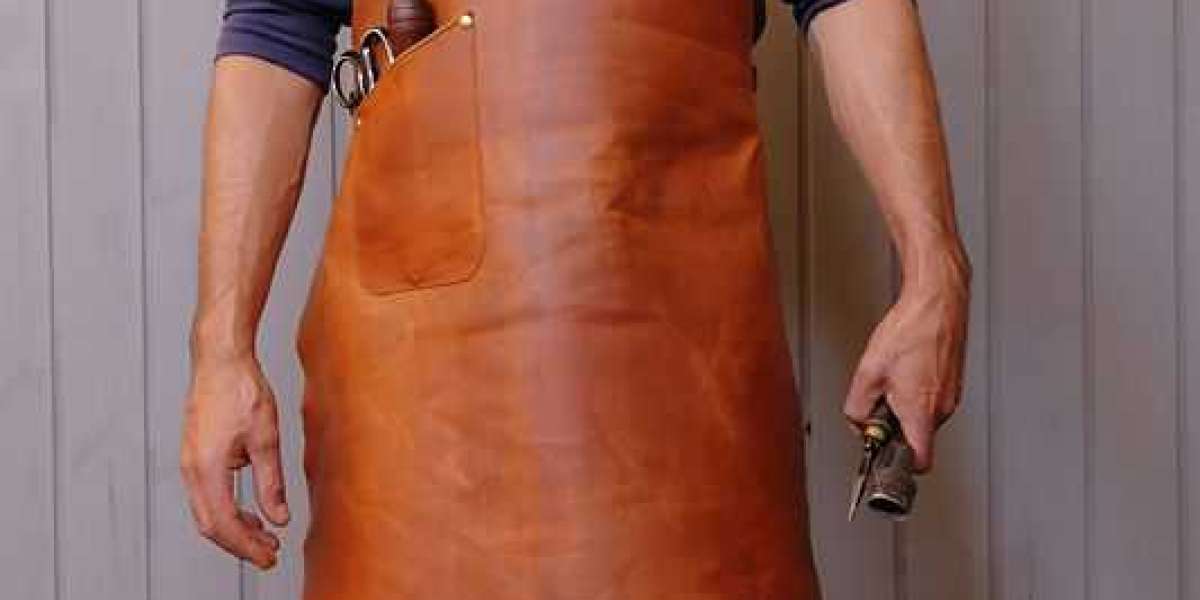Leather aprons have a rich history and enduring presence in various trades and crafts. From blacksmiths to baristas, chefs to carpenters, these aprons have been essential for centuries, providing protection, durability, and a touch of style. The appeal of a leather apron extends beyond its practical applications; it also represents a blend of tradition, craftsmanship, and aesthetics that continues to resonate in modern times. This article explores the multifaceted world of leather aprons, delving into their history, uses, benefits, and the reasons behind their timeless appeal.
A Brief History of Leather Aprons
Leather aprons have been a staple in various trades for centuries, their origins tracing back to ancient civilizations. The use of leather as a protective material is almost as old as humanity itself. Early humans used animal hides to shield themselves from the elements, and as they developed tools and crafts, leather became the material of choice for protective garments, including aprons.
In medieval Europe, leather aprons were widely used by blacksmiths, butchers, and other craftsmen. The durability and resistance to heat and sharp objects made leather the ideal material for those working with fire, metal, and sharp tools. As trades and guilds became more established, the leather apron became a symbol of a craftsman’s skill and trade. For instance, the blacksmith’s apron was not just protective gear but also a badge of honor, representing the strength and craftsmanship of the wearer.
The Versatility of Leather Aprons in Modern Times
Today, leather aprons are no longer limited to traditional trades. They have found their way into various modern professions and hobbies, thanks to their versatility and stylish appeal. Below are some of the most common uses of leather aprons in contemporary settings.
In the Culinary World
One of the most visible modern uses of leather aprons is in the culinary world. Chefs, baristas, and bartenders often wear leather aprons not just for protection but also as a statement of professionalism and style. The leather apron adds a touch of rustic elegance to the kitchen or bar, setting the wearer apart as a serious professional.
Leather aprons in the culinary world serve multiple purposes. They protect the wearer from spills, splashes, and heat, much like their historical counterparts. However, they also contribute to the ambiance of the establishment, especially in high-end restaurants or artisanal coffee shops. The aesthetic appeal of leather aprons complements the overall vibe of such places, creating a cohesive and sophisticated look.
In Workshops and Craftsmanship
Leather aprons remain a staple in workshops, particularly in trades like woodworking, metalworking, and leathercraft itself. Craftsmen and artisans who work with sharp tools, heavy machinery, or potentially hazardous materials rely on leather aprons for protection. The thick, durable leather shields the body from cuts, burns, and abrasions, making it an essential piece of equipment in these settings.
Moreover, leather aprons in workshops often feature multiple pockets and loops for holding tools, nails, and other necessities. This functionality is another reason why leather aprons continue to be favored in trades that require easy access to tools and materials. The ability to keep everything within arm’s reach enhances efficiency and productivity, making the leather apron not just a protective garment but a valuable tool in itself.
In Fashion and Lifestyle
Beyond their practical uses, leather aprons have also made their mark in the fashion and lifestyle industries. High-end leather aprons are now seen as a stylish accessory, worn by individuals who appreciate the blend of form and function. These aprons are often customized with unique designs, monograms, or embellishments, making them a personal statement as much as a functional item.
In the world of home cooking and DIY, leather aprons have become a popular choice for hobbyists who want to combine style with practicality. Whether it’s for grilling, gardening, or crafting, a leather apron adds a touch of sophistication to any activity. The durability of leather means that these aprons can withstand years of use, aging beautifully over time and becoming even more attractive with wear.
The Benefits of Choosing a Leather Apron
The enduring popularity of leather aprons is not just due to their historical significance or aesthetic appeal. There are several practical benefits to choosing a leather apron over other materials.
Durability and Longevity
One of the primary reasons for the continued use of leather aprons is their durability. Leather is a naturally tough material that can withstand significant wear and tear. Unlike fabric aprons, which can easily tear, stain, or wear out, leather aprons can last for years, even with heavy use. This longevity makes them a cost-effective choice, especially for professionals who require reliable protection over long periods.
The durability of leather also means that it can handle rough treatment in workshops or kitchens. It resists punctures, cuts, and abrasions, offering superior protection against accidents. Additionally, leather is relatively easy to clean and maintain, requiring only occasional conditioning to keep it supple and prevent cracking.
Heat and Fire Resistance
Leather is naturally resistant to heat and fire, making it an ideal material for aprons used in high-temperature environments. This property is particularly important for blacksmiths, welders, and chefs, who work with open flames, hot surfaces, or molten materials. A leather apron provides a crucial layer of protection, reducing the risk of burns and other heat-related injuries.
The fire resistance of leather also adds a layer of safety in environments where sparks, hot metal, or embers are common. While no material is entirely fireproof, leather offers a significant advantage over synthetic or fabric alternatives, which can easily catch fire or melt.
Comfort and Fit
Contrary to what one might expect, leather aprons can be quite comfortable to wear. Over time, leather conforms to the shape of the wearer’s body, creating a personalized fit that enhances comfort. The weight of the leather is often evenly distributed, especially in well-designed aprons, reducing strain on the neck and shoulders.
Many leather aprons are also adjustable, with straps and buckles that allow for a customized fit. This adaptability ensures that the apron remains securely in place during use, preventing unnecessary movement or discomfort. For professionals who wear their aprons for long hours, the comfort provided by leather is a significant benefit.
Aesthetic Appeal
Leather aprons possess a unique aesthetic that blends ruggedness with sophistication. The natural texture and grain of leather give each apron a distinct appearance, with variations in color and pattern that add character. As leather ages, it develops a patina, a soft sheen that enhances its beauty and gives it a lived-in look.
This aesthetic appeal is one of the reasons why leather aprons have become popular in settings beyond the workshop or kitchen. They are often seen in high-end retail environments, artisanal markets, and even as part of a stylish home decor. A leather apron can be both a functional item and a conversation piece, making it a versatile addition to any wardrobe or workspace.
Caring for a Leather Apron
To ensure the longevity and appearance of a leather apron, proper care is essential. Leather is a natural material that requires regular maintenance to keep it in good condition. Here are some tips for caring for a leather apron:
- Cleaning: Wipe the apron with a damp cloth to remove dirt and spills. Avoid using harsh chemicals or soaps, as these can damage the leather. For stubborn stains, a mild leather cleaner can be used.
- Conditioning: Leather should be conditioned periodically to prevent it from drying out and cracking. Use a high-quality leather conditioner, applying it evenly across the surface and allowing it to absorb fully.
- Storage: Store the leather apron in a cool, dry place, away from direct sunlight, which can cause fading. If possible, hang the apron rather than folding it to prevent creases and wrinkles.
- Avoiding Water Damage: While leather is somewhat water-resistant, prolonged exposure to moisture can cause damage. If the apron gets wet, allow it to dry naturally, away from heat sources, and then condition it to restore moisture.
Conclusion
The leather apron is more than just a piece of protective clothing; it is a symbol of craftsmanship, durability, and style. Whether in a workshop, a kitchen, or a fashion-forward lifestyle, the leather apron has proven its versatility and timeless appeal. Its combination of functionality, comfort, and aesthetic value ensures that it will remain a cherished item for generations to come.
As we continue to appreciate the blend of tradition and modernity, the leather apron stands out as a testament to the enduring quality of materials and design that transcend time. Whether worn by a master craftsman or a home chef, the leather apron is a piece of heritage that connects us to the past while serving our present needs with elegance and efficiency.








